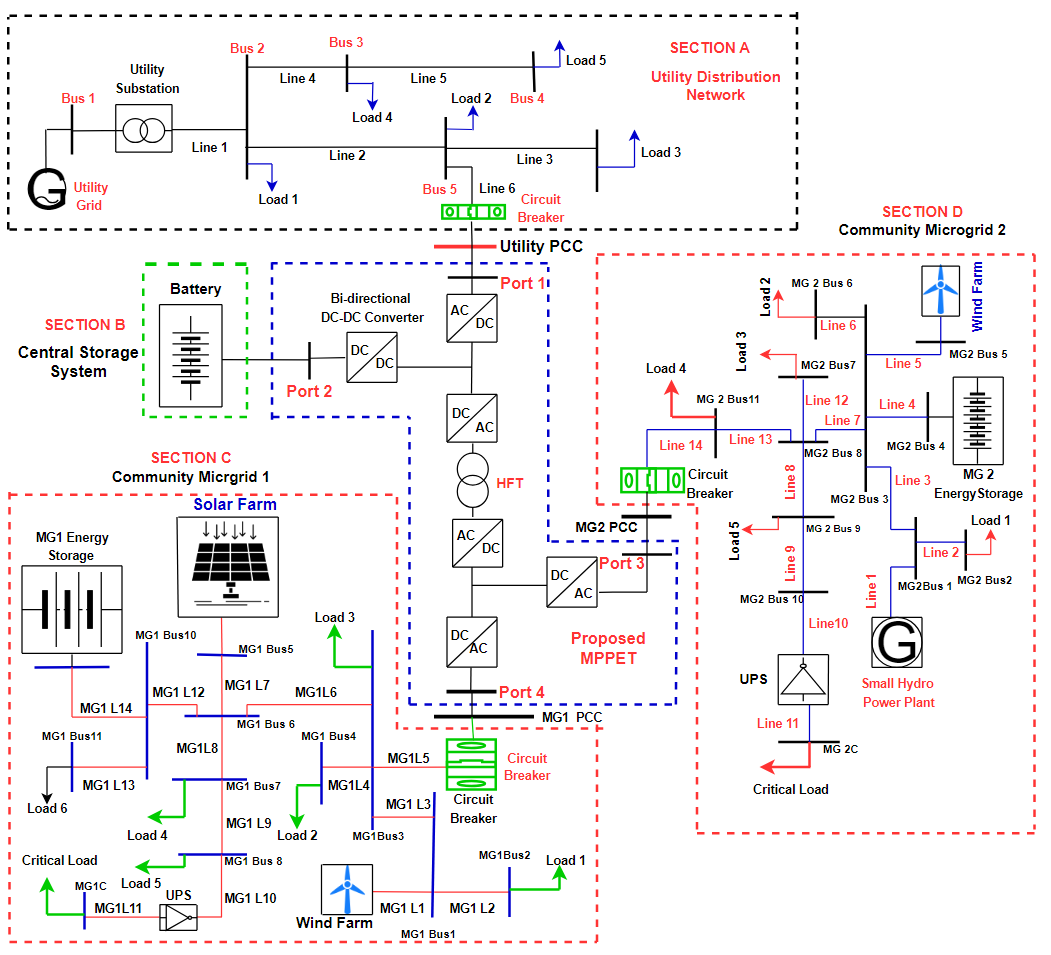Found 2 results
Article
04 June 2024Investigating and Analyzing the Impact of a Bidirectional Multiport Power Electronic Transformer Interface on the Power Quality and Stability of Interconnected Microgrids
This paper investigates the potential benefits of a bidirectional multi-port power electronic transformer (MPPET) to interface multiple microgrids with utility distribution networks in terms of power quality and stability. The main concept is based on the interaction between the utility grid, the connected microgrids, and the MPPET in controlling the disturbances that lead to grid instability and power quality issues. The proposed MPPET does not require any serious communication infrastructure for operation. In addition, the MPPET can respond to reverse power flow caused by excess power generation on the grid. Due to the intermittent nature of the renewable energy sources and the different stages involved in the design of the proposed MPPET, the system is liable to internal DC voltage fluctuation, causing grid instability; thus, an energy storage system (ESS) is incorporated to avert the challenges. The networks under investigation and the proposed MPPET are designed and simulated using MATLAB and Simulink software. The electrical isolation capability of the proposed bidirectional MPPET is verified through simulation. Several case studies have been carried out to evaluate the behavior of the system under different operating conditions and to check the feasibility of MPPET for power quality improvements. It was observed that the MPPET is proficient in regulating power quality issues, thus enhancing grid stability. It is also varied that the proposed MPPET prevents the escalation of the impact of faults or disturbances all over the grid. At the same time, it is verified that the proposed bidirectional energy storage systems enhance energy transfer between the utility grid and microgrids, which improves the system’s stability.

Review
14 November 2023Microgrids Overview and Performance Evaluation on Low-voltage Distribution Network
Besides the increase in global energy demand, access to clean energy, reduction in greenhouse gas emissions caused by conventional power generation techniques, energy security, and availability of electricity in remote villages in emerging nations are some of the factors that foster the use of renewable energy sources (RESs) in generating electricity. One of the aims of initiating microgrids (MGs) is to maximize the benefits of RES while alleviating grid-connect issues. Microgrids are interconnected RESs and electrical loads within clearly delineated electrical limits that operate as individual controllable units on the electrical network. It can operate independently and be grid-connected. The paper presents a review and performance assessment of renewable energy-based microgrids under various operating scenarios in stand-alone, grid-connected, and transitioning modes of operation. Fault occurrences, an increase in micro-source generation, a load increase, and the sudden disconnection of a micro-source are some of the simulated scenarios. Microgrid network components’ performance, such as the bidirectional DC-DC converter and energy storage system (ESS), was evaluated. The simulated microgrid architecture includes a small hydroelectric plant, wind farm, and ESS. The work provides valuable information to energy stakeholders on the performance of microgrids in low-voltage distribution networks. The microgrid is coupled to a low-voltage distribution network (0.415 kV) via a PCC. The system under investigation is modeled and simulated using MATLAB/Simulink. From the simulation analysis, the fault effect was felt on the utility and did not escalate to the microgrid side during stand-alone operation. Power quality issues, such as voltage rise, are some of the challenges identified during the transition from one mode of operation to another. However, the energy storage system responds to disturbances and maintains system stability. The originality of this paper is based on evaluating different modes of operation of microgrids and comparing system performances under various operating conditions.
